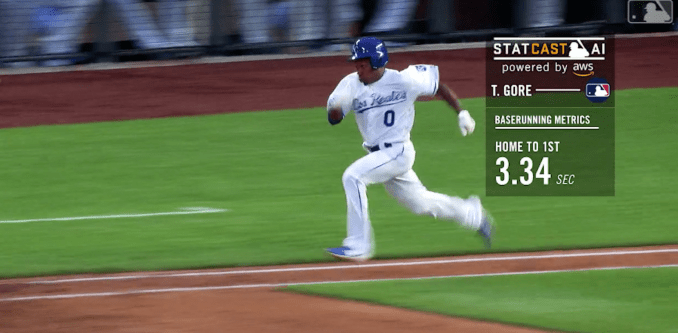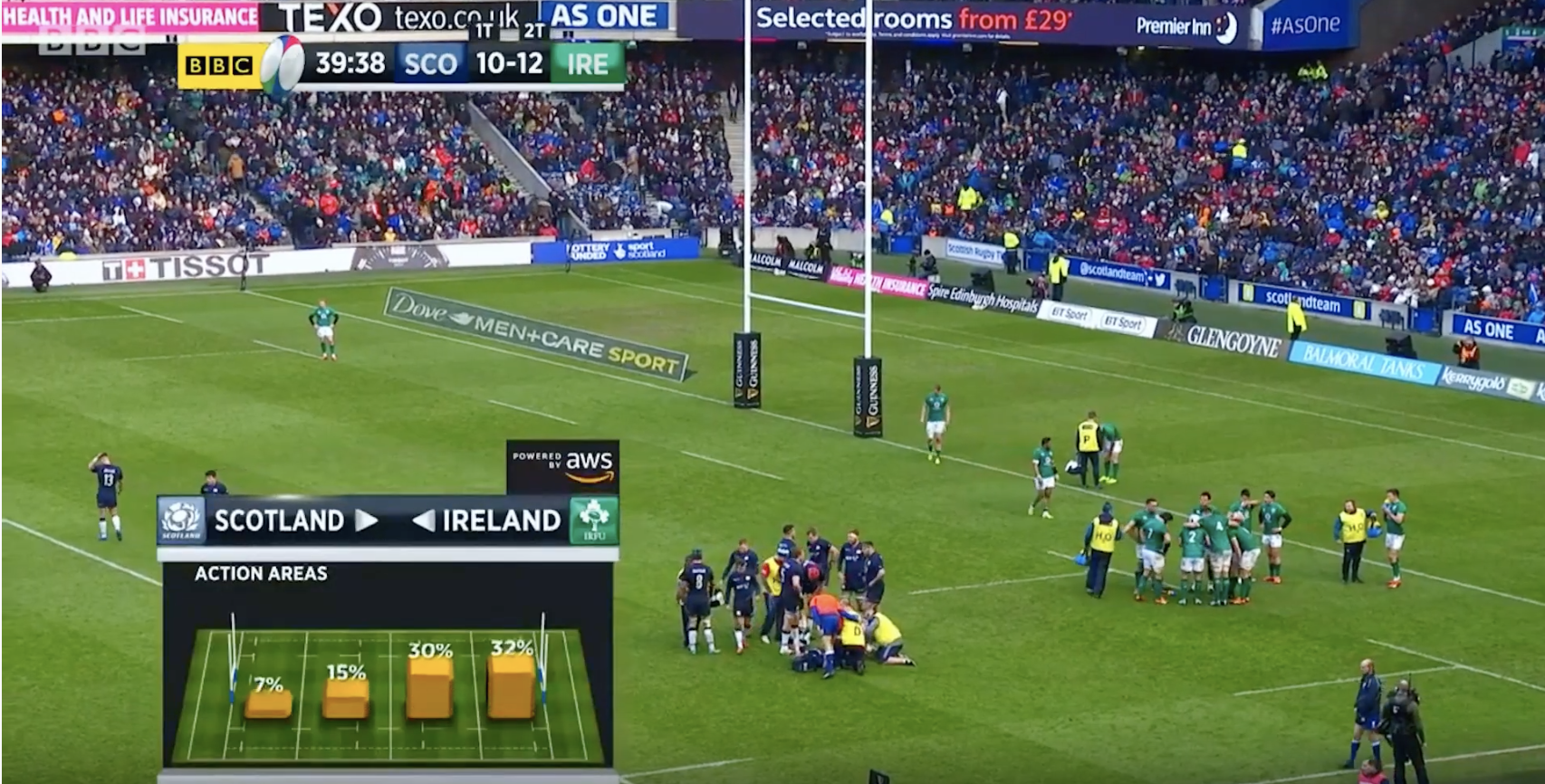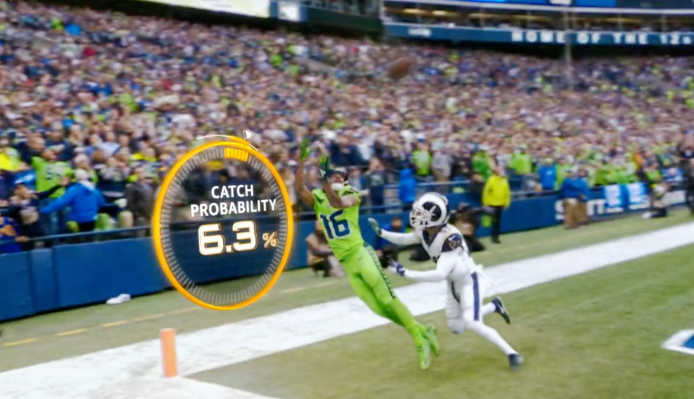Since the inception of professional sports, fans have sought statistics about how their favorite teams and players are performing. Until recently, these stats were generated from basic counting, like batting averages, home runs or touchdowns.
Today, sports leagues are looking to learn more about players and find a competitive edge through more advanced stats. Beyond that, they want to engage fans more with tools like AWS NFL’s Next Gen Stats and MLB’s Statcast, software that uses compelling visuals to illustrate statistics like the probability of receiving a catch in the end zone or a runner’s speed between home and first base.
AWS counts Major League Baseball, the National Football League, the German Bundesliga soccer league, NASCAR, Formula 1 racing and Six Nations Rugby among its customers. How, exactly, are advanced cloud technology and machine learning helping change how we watch live sports?
Building on Moneyball
When Michael Lewis published Moneyball in 2003 (later a Brad Pitt movie), he shined a spotlight on the Oakland A’s pioneering work with advanced statistics, known as Sabermetrics. Soon, other teams began to pay attention, then other sports. Once it became clear that teams could learn a lot by studying advanced statistics, they began hiring stats geeks and building systems to crunch numbers. That was prior to 2010, before the cloud became mainstream.
As this was happening, the growing popularity of fantasy sports leagues made fans more interested in advanced statistics because participants build teams and earn points based on individual player performance. That data has grown more sophisticated over time as fans seek to gain an edge in their fantasy play, and so two main reasons for displaying more advanced stats began to merge.
Over the last decade, machine-learning technology has been advancing: Now, AWS offers statistics packages to some of the world’s top sports organizations that specifically highlight advanced metrics.

MLB Statcast measures the speed of runner Trevor Gore of the Kansas City Royals from home plate to first base (Photo: MLB/AWS)
It’s all about the data
One of the things pushing AWS’s productization of stats packages for sports leagues is the growing amount of data available to fuel machine-learning efforts. Because leagues are awash in current and historical information — ranging from video archives to detailed injury stats — the NFL can evaluate catch probability, MLB can look at launch angle and exit velocity when a ball leaves the bat and Formula 1 can see how likely it is that one car could pass another. These advances help teams as they look for a competitive edge and also improve fan experiences at live events or when watching at home.
Werner Vogels, CTO at Amazon, says while it’s partly about boosting on-field results, packaging statistics improves the experience for fans watching with different kinds of augmentation of the game, particularly those using mobile devices. “It is really also engaging with a whole new generation of fans who expect this kind of mobile experience and mobile augmentation of the experience while they are in the stadium, or while they’ve been sitting on their commute coming home,” he said.
NBC Sunday Night Football analyst Cris Collinsworth, speaking on a panel called “Transforming Sports Through AI” at AWS re:Invent last month, says with so much data, you have to be careful that you don’t overwhelm casual fans with too much information.
“If you start plastering stuff all over the screen and making it all about that, you’re going to make a segment of the audience happy, but you’re going to distract the great majority — but those who want it, want it badly,” he said. Collinsworth is also CEO of Pro Football Focus, a company that looks at advanced football statistics used heavily by both teams and fantasy players.
The physical-digital connection
Vogels says from a technology perspective, his company’s technology and others like it help bridge the physical and virtual worlds. “What I’m interested [in] these days — and it doesn’t only go for sports — is how the physical world, the real world around us, and the digital world, how the boundaries between those are starting to become fairly vague,” he said.
He said that involves using digital systems to enhance what’s happening in the physical world. “Given the emotions and the excitement we put into our sports, this is an ideal opportunity to look at both historical data, as well as in real time to see how we can enhance this,” he said.

Forumla 1 Insights can predict how long it will take for one car to overtake another (Photo: Formula 1/AWS)
The beauty of sports is that it can act as a bridge to other business needs in terms of how the physical and digital converge that could be valuable far beyond enhancing the fan’s viewing experience. “It’s a bit broader topic than just sports. You should think about manufacturing, you think about the life sciences, you think about many different areas like home automation, all these kind of areas where physical and digital are blending together,” he said.
Updating the viewing experience
As Vogels points out, many sports organizations have a very loyal fan base, but they are getting older. “Older fans are used to a traditional way of looking at their sport, but there is a whole new generation of fans coming up, and it is crucial that [these sports] supply new forms of engagement which the younger generation absolutely [demands] to actually create a great new customer experience,” he said.

Six Nations Rugby match with AWS MatchStats on screen (Photo: Six Nations Rugby/AWS)
German football league Bundesliga announced last week that it was launching a partnership with AWS to improve the experience for its fans that involves advanced statistics like predicting the probability of a potential goal and delivering personalized content to users, all in the name of improving their fan experience.
Will Carling, former captain of the English team in the Six Nations rugby championship, says he suggested to AWS that it get involved with the league for a similar reason — younger fans were hungry for information beyond the action taking place on the field. “Having key stats can explain exactly what happened in that game,” he said in a video introduction to AWS’s relationship with the league. Six Nations’ AWS rugby stats are called MatchStats.
To the cloud
Other cloud infrastructure vendors are also working with sports leagues: Microsoft is involved with several fan experience projects, including with the NFL and top Spanish football league La Liga. The NFL also has designated Microsoft Surfaces as its official laptops, which are used during games. Google worked with the NCAA last year on the March Madness basketball tournament, so there are lots of other examples of this across the industry and across sports.
Cloud vendors are also working with league data to increase player safety and enhance performance. AWS and the NFL held a news conference at AWS re:Invent to discuss their partnership around improving player safety, as an example.
When AWS and Bundesliga announced their partnership, Vogels saw it as a blueprint for other leagues, but with many major sports organizations on board, it is well on its way to achieving that, even as other cloud vendors attempt a similar approach.
